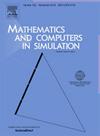Vertically averaged multi-constituent flow simulations of geological CO2 sequestration — Stabilized finite element methods and quadratic elements
IF 4.4
2区 数学
Q1 COMPUTER SCIENCE, INTERDISCIPLINARY APPLICATIONS
引用次数: 0
Abstract
This paper compares several stabilized Finite Element Methods (FEMs) at solving the vertically averaged multi-constituent flow for CO2 sequestration. Non-physical oscillations can occur when using the Galerkin FEM. Linear elements have been previously studied and are not able to provide a complete representation of the stabilization term in the consistent stabilized FEMs. Quadratic elements solve this problem and also allow additional formulations to be compared.
Stability is not guaranteed when using implicit time integration on non-linear advection dominated problems. Therefore, several stabilization methods are considered: the Streamline-Upwind (SU and SU-) method, the Streamline-Upwind Petrov–Galerkin (SUPG) method, the Galerkin Least Squares (GLS) method, the Subgrid Scales (SGS) method, and the Hughes Variational Method (HVM).
Quadratic elements and consistent formulations improve stability when discretizing in time first. Inconsistent methods (SU and SU-) can perform well with linear or quadratic elements, however they are especially susceptible to over-diffusion. Suitable stabilization methods can be obtained for various injection scenarios, by selecting an appropriate combination of stabilization method, stabilization parameter, Courant number and element size.
地质CO2封存的垂直平均多组分流动模拟——稳定有限元法和二次元法
本文比较了几种稳定有限元法在求解二氧化碳固存过程中垂直平均多组分流的应用。当使用伽辽金有限元法时,非物理振荡可能发生。线性单元以前已经被研究过,但不能提供稳定项在一致稳定fem中的完整表示。二次元解决了这个问题,也允许对其他公式进行比较。对非线性平流主导问题采用隐式时间积分时,稳定性得不到保证。因此,考虑了几种稳定方法:Streamline-Upwind (SU和SU-8τ)方法,Streamline-Upwind Petrov-Galerkin (SUPG)方法,Galerkin最小二乘(GLS)方法,子网格尺度(SGS)方法和Hughes变分方法(HVM)。二次元和一致性公式首先在时间离散时提高了稳定性。不一致方法(SU和SU-8τ)可以很好地处理线性或二次元,但它们特别容易受到过度扩散的影响。通过选择合适的稳定方法、稳定参数、科朗数和单元尺寸的组合,可以得到适合不同注入场景的稳定方法。
本文章由计算机程序翻译,如有差异,请以英文原文为准。
求助全文
约1分钟内获得全文
求助全文
来源期刊

Mathematics and Computers in Simulation
数学-计算机:跨学科应用
CiteScore
8.90
自引率
4.30%
发文量
335
审稿时长
54 days
期刊介绍:
The aim of the journal is to provide an international forum for the dissemination of up-to-date information in the fields of the mathematics and computers, in particular (but not exclusively) as they apply to the dynamics of systems, their simulation and scientific computation in general. Published material ranges from short, concise research papers to more general tutorial articles.
Mathematics and Computers in Simulation, published monthly, is the official organ of IMACS, the International Association for Mathematics and Computers in Simulation (Formerly AICA). This Association, founded in 1955 and legally incorporated in 1956 is a member of FIACC (the Five International Associations Coordinating Committee), together with IFIP, IFAV, IFORS and IMEKO.
Topics covered by the journal include mathematical tools in:
•The foundations of systems modelling
•Numerical analysis and the development of algorithms for simulation
They also include considerations about computer hardware for simulation and about special software and compilers.
The journal also publishes articles concerned with specific applications of modelling and simulation in science and engineering, with relevant applied mathematics, the general philosophy of systems simulation, and their impact on disciplinary and interdisciplinary research.
The journal includes a Book Review section -- and a "News on IMACS" section that contains a Calendar of future Conferences/Events and other information about the Association.
 求助内容:
求助内容: 应助结果提醒方式:
应助结果提醒方式:


